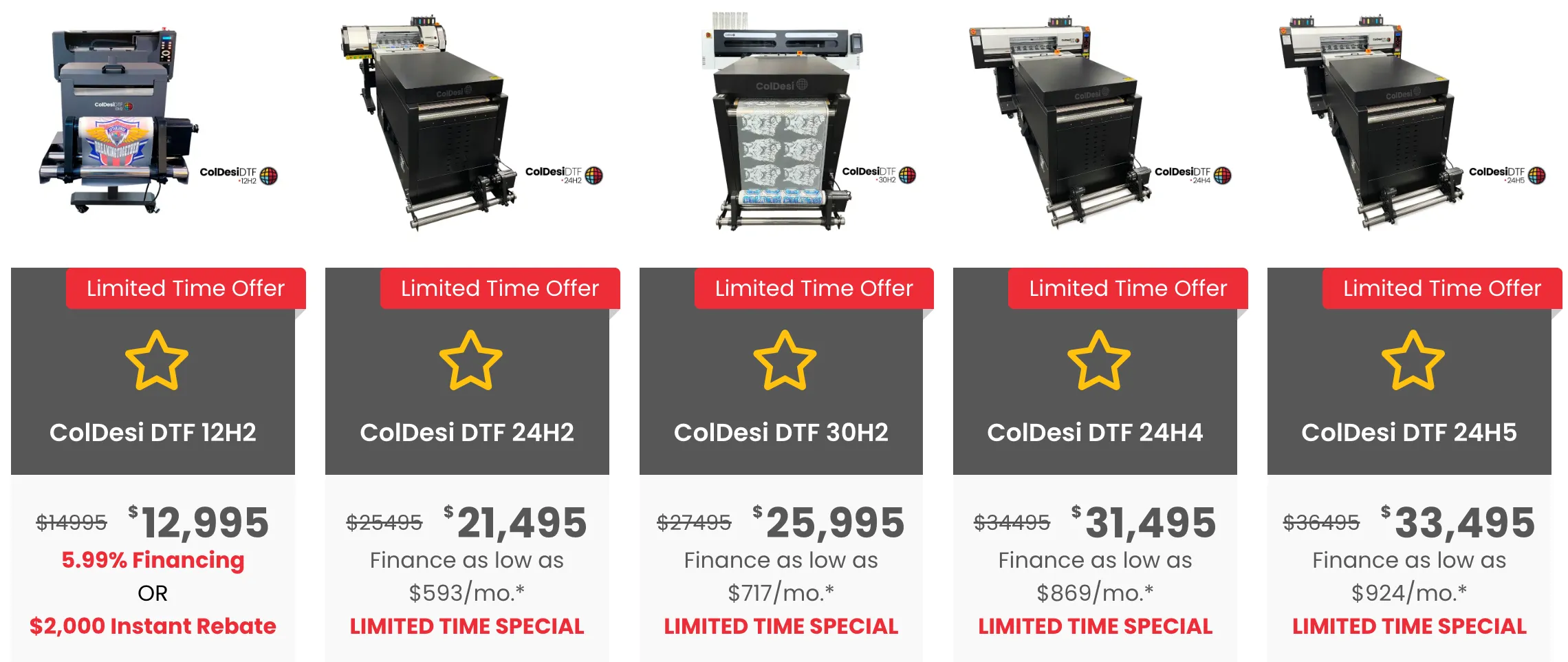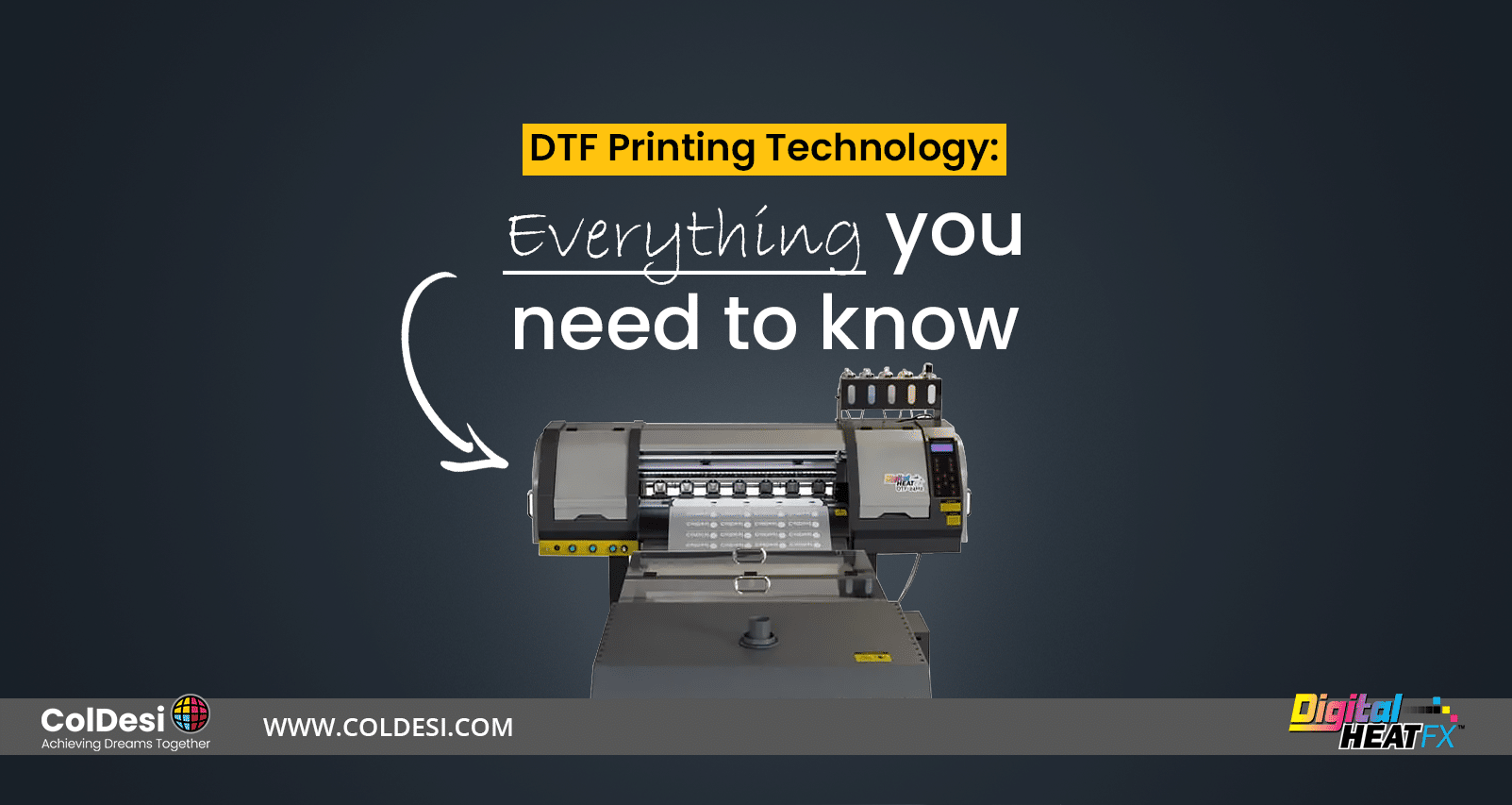Welcome to your one-stop destination for, well, basically all the things DTF related.
On this page, we’ve rounded up every single thing you need to know about direct-to-film (DTF) technology.
To start off, we’ll take a small step and begin by learning what DTF printing technology is. After that, we’ll move into more of the numbers side of things and lay out the typical investment required for a DTF setup. And of course, that goes along with us breaking down and explaining all the factors that make up those figures!
Once we’ve covered the basics, we’ll explore the advantages and benefits of upgrading to DTF. And, if you’ve stuck with us this far, you’re probably considering purchasing one yourself. For those ready to take the next step, we’ll walk you through the essential considerations before making a purchase and point you in the right direction to get started.
Plus, we’ll share some of our pre-recorded videos on the topic with you and give lots of really good real life examples.
So, if that sounds of interest to you, keep on reading.
Understanding the Basics:
What is DTF Printing Technology?
Perhaps we should get basics out of the way first. To do that, we’ll pretend you’ve never even heard of DTF before, let alone worked with it.
In that case, we have a lot of catching up to do.
Just so we’re on the same page, let’s start with some basic definitions. What is DTF, and what does it stand for?
DTF is an acronym that stands for direct-to-film, which essentially is a new printing technology and process in the custom apparel (and product) decoration industry.
Until recently, decorators used traditional methods like screen printing, white toner printing, direct-to-garment (DTG), embroidery, or even a mix of these to add patterns, graphics, and text to products.
But times have changed, and it’s all about DTF now. It far outperforms traditional methods of printing in pretty much every area; image quality, speed, durability, efficiency, and cost-effectiveness in a longer time-horizon.
Surprisingly, the way it works is remarkably similar to white toner printing, so decorators familiar with that method will feel right at home.
Let us walk you through the whole process of how it works before we get to the numbers side of things, that way you get a solid theoretical foundation.
It’s worth getting to know it; we’ll zip through it, keep it on point, and do our best not to put you to sleep. So stick with us, okay?
Direct-to-Film (DTF), How it Works?
Listen, if you’re going to be the one ‘’behind the wheel’’ of DTF printer, you need to know how it works to use it! To give you a helping hand, let us walk you through its typical printing process.
The process begins with something you’re likely already familiar with—browsing the internet for various decoration ideas and reference graphics. From there, it’s a matter of working in graphics software to prep them for printing.
The first part is easy enough, making graphics print-ready is where it gets a little harder to figure out. But lucky for you, that can be solved either by our ‘’ColDesi Graphics’’ department… or… files sold online.
Now that you have selected and prepped a design of your choice, what’s the next step in the process? –Keeping in mind that we are referring to apparel DTF printers rather than the also popular UV-DTF printers.
Well, the logical next step would be to start printing out that design. At the press of a button, you can get it underway.
The printer will then do its magic and pull the translucent PET (polyethylene terephthalate) film over to the print head for printing. Your design will get printed in a mirrored position, layer-by-layer. The color will be laid down first, followed by the application of white ink.
After the ink is applied, the DTF film will pass through a powder-shaker unit. This unit deposits a type of polyurethane (TPU) hot-melt adhesive powder onto the back of the film (and ink), and to ensure even spreading, it is shaken by a vibrating mechanism.
Finally, the DTF film enters the heating chamber. Here, it heats up the hot-melt glue and finishes curing the inks themselves, so that when it comes out the back it’s ready for use.
And there you have it, that’s a simplified version of how direct-to-film (DTF) printers work.
Now let’s carry on and look at how much does it cost to get this thing up and running in your workshop.
You can read more about how DTF printing process works by clicking here.
Weighing the Investment:
How Much Does a DTF Printer Cost?
So, let’s talk about the elephant in the room—the cost of a DTF printer, and whether it’s a smart investment for your workshop.
Principally, there are three types of DTF printers that you can choose from—DTF 12H2, DTF 24H2, and DTF 24H4! Each one has its own unique characteristics that define it, making it ideal for specific user groups.
For power users, DTF 24H4 stands out as the top pick, and they’ve really went all out on this one. With 4 print heads, it delivers impressive print speeds and maximum output of up to 145 linear feet per hour. And for around $29,995, it can be yours!
If you’re not quite a power user or looking for something in between, there’s a perfect option for you—the DTF 24H2! It comes in at around $19,995 (as of this writing), and offers absolutely fantastic value for money.
Now, if you’re not ready to invest in the larger systems and just want to get the ball rolling, you can get started with DTF 12H2 for around $14,995! Combine that with financing, and you can spread out the total cost over a longer period, putting you at around $414 per month (as of now).
As you can see, there are three models to choose from, each falling into different price categories with payment options to make them more affordable.
Whichever one you choose, is up to you!
Next, let’s take a closer look at components and pre-requisites that make up the price of ‘’installing’’ a DTF printer in your workshop.

Take a look at this article to compare DTF set-up costs with traditional methods of printing.
Factors Affecting the Bottom Line:
What Influences DTF Printer Costs?
Now, by this point, you’re beginning to wonder whether you have space in your studio for a DTF printer.
Because they’re not exactly known for being small, thin, and lightweight, a quick look at the product’s page shows that they can take up between 39.5″ x 65″ to 78″ x 132″ inches of space, depending on the model.
This should be in your head when thinking about buying one of these printers.
But it’s not just the size of a printer that you should factor in, ventilation is another major thing.
While DTF printing is on the environmentally greener side, it does generate minimal volatile organic compounds (VOCs) and releases air pollutants.
Therefore, it’s in your best interest to install proper ventilation to keep the workplace well-ventilated. You might also want to invest in a DTF fume extractor that can absorb and extract any smoke or fumes produced during the printing process.
This, among other things, has a direct influence on the total cost.
But it’s all worth it, as direct-to-film (DTF) technology comes with a number of benefits and advantages that decorators will appreciate.
So, let’s talk about them next.
Unveiling the Advantages:
Exploring the Benefits of DTF Printing Technology
Let’s explore the range of benefits and advantages that come with owning a direct-to-film (DTF) printer:
- Reliability: So far, there is virtually no one system that has proven to be as reliable as DTF. Over the years and hundreds of production hours, DTF printers have shown to be extremely consistent and stable.
- Efficiency: Powered by RIP Print Optimizer Software, DTF printers are incredibly efficient. Oftentimes, decorators need to tweak designs or play around with settings for the perfect output, and now, you can do so more easily than ever at the software level.
- Durability: You will find that DTF printers are built remarkably durable and sturdy. The construction and overall design of these printers are well above and beyond the average.
- Cost-effectiveness: DTF printers are more economical to run than traditional printing systems. You can save up to 50% on white ink costs alone.
- Profitability: Your investment in a DTF printer will likely pay itself back many times over.
- Productivity: All of this combined has a huge effect on productivity whilst working. You'd be surprised by how much you can get done with DTF.
- Print Quality: The prints come out of the printer in full-color, sharp and crisp, allowing you to press them onto both white and black, soft and hard-surface items.
- Versatility with Materials: DTF prints can be pressed onto a variety of soft and hard-surface materials, including cotton, nylon, treated leather, polyester blends, ceramics, wood, metal, and plastic that does not melt under heat.
- Technical Support and After-Sales Service: In case of an unwanted accident, an unknown error, or a breakdown of the DTF machine, you can have peace of mind knowing there is technical support and after-sales client service available to assist you.
Key Considerations: What You Need to Know About DTF Printing
If you’ve stuck with us this far, you’re likely thinking about buying a DTF printer. For those ready to take the next step, there are a few key considerations to make before purchasing one. And so let’s just go through and look at them real quick.
- Size: We touched upon this point briefly before, but size is a thing. You need to look at your workspace, take accurate measurements, and be realistic if you can fit these printers. For those dealing with limited space, you may need to consider some minor construction adjustments to make room for them.
- Ventilation: The next thing to consider is ventilation. This means that you’d need to keep the room well ventilated and regularly refilled with fresh air. So, you might need to install a ventilation and air filtration system for that.
- Labor & Personnel: Even if DTF printers run by themselves, they need personnel who control all the manual operations.
- Training: To acclimate and ready your staff (or yourself) for DTF, you’ll need to plan for enough time for practice and training.
- Equipment: Another thing to think about (besides those already on the list) is equipment. If you're starting from ''ground zero'', you’ll need accompanying equipment like a heat press and computer.
- Consumables: You’ll also need to regularly replenish your supplies with plenty of DTF film, ink, powder, and other consumables that you don’t have in your arsenal.
- Care & Maintenance: Much like any other equipment, DTF printers need constant care and upkeep!
Of course, there are plenty of other things to think about besides those on the list. This, of course, is just an overview to get you thinking.
Now, as we’re nearing the end of this article, let’s wrap up and talk about one last thing we haven’t discussed—how to get your hands on a DTF printer, and where.
Finding Your Fit: Where to Purchase DTF Printers
You’ve made it through to the end of this post, congratulations! You’re well-informed on what DTF is, how it functions, and what it takes to get started!
The missing link? Where to buy it. But fear not, because you won’t have to search far. You can order a DTF printer right here on this website.
Use the button below to view and cross-compare our lineup of DTF printers.
To learn more about ColDesi’s line of direct-to-film (DTF) printers, visit coldesi.com and Live Chat with a Pro below, or call 877.793.3278.









